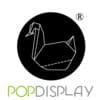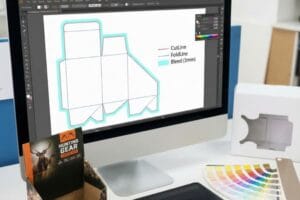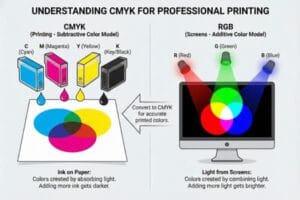Shoppers face too many choices. Shelves look busy. Staff work fast. I need one clear tool that lifts visibility, speeds setup, and keeps cost low. Cardboard display boxes do that.
Cardboard display boxes are printed paperboard or corrugated structures that hold, protect, and present products at retail; they ship flat, assemble fast without tools, carry brand graphics, and boost impulse sales while staying recyclable and cost-effective.
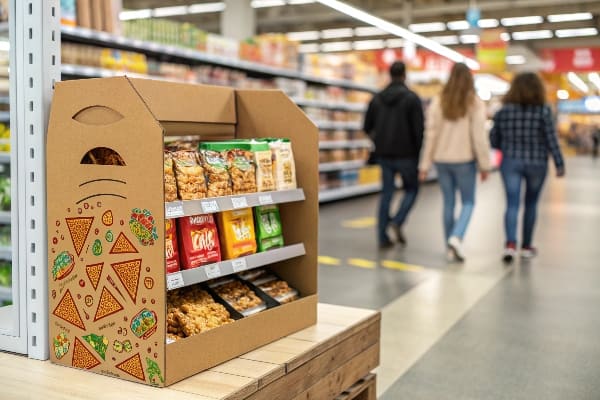
I design and make these every day in Shenzhen. I see what works in the U.S., Canada, the U.K., and Australia. Keep reading. I will share simple rules, clear names, and real factory tips.
What are the benefits of cardboard boxes?
Crowded aisles hurt attention. Heavy fixtures slow changeovers. Budgets are tight. I need packaging that protects in transit and still sells on shelf. Cardboard boxes give me that mix.
Key benefits include low material cost, light weight, fast lead times, easy custom printing, strong protective strength-to-weight, and simple curbside recyclability that fits retailer and brand sustainability goals.
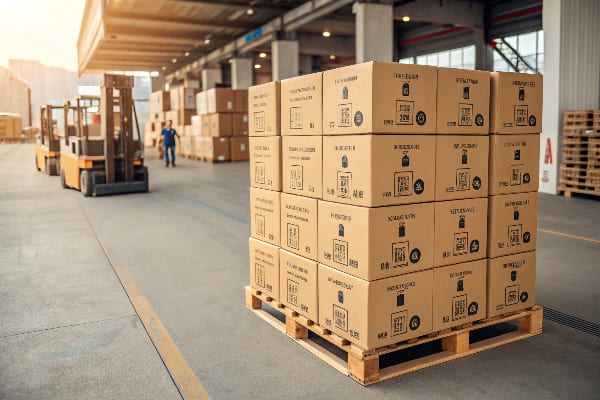
Cost and speed
I control cost with standard flute grades and efficient die lines. Digital printing lets me make short runs for tests. Lead times stay short because sheets cut, print, and glue on the same day for simple jobs. This helps seasonal or launch windows. I keep three lines ready for rush orders, and I build samples fast so teams approve designs without delay.
Sustainability and compliance
Cardboard fits store recycling streams. I spec FSC or recycled content1 on request. Water-based inks help compliance. This reduces risk with buyers who prefer low VOC materials. Light weight also cuts freight emissions.
Performance and design
I choose single-wall for most cases and reinforce stress points with inserts. I add tear-away SRP fronts so staff open boxes fast. Good design reduces damage and returns. Good graphics tell a clear story in seconds.
| Aspect | What it means | Why it matters |
|---|---|---|
| Cost | Low material and tooling | Easier budget approvals |
| Speed | Short setup and print cycles | Hit promo dates |
| Strength | Right flute and folds | Fewer damages |
| Full-bleed brand panels | Faster shopper decisions | |
| Green | Recycled and recyclable | Retailer acceptance |
What are cardboard displays called?
Teams use many names. This creates confusion. I align terms early so buyers, designers, and factories talk about the same thing. Clear names speed quotes and samples.
Common names include POP displays, POS displays, floor displays, pallet displays, countertop displays, PDQ trays, shelf-ready packaging, dump bins, endcaps, standees, clip strips, and hang tabs.
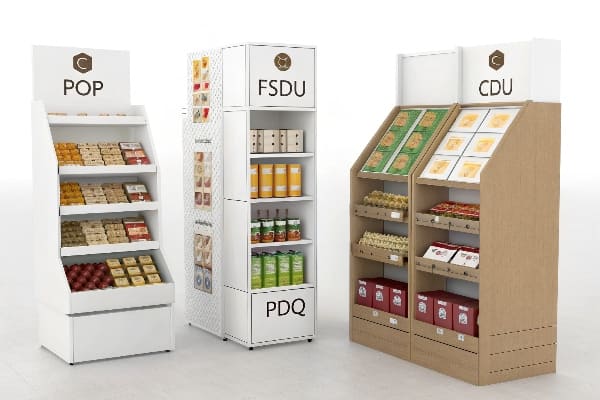
Regional language
In North America, people say POP. In the U.K. and Europe, people say POS. Both mean point-of-purchase displays2. I confirm the exact format in the brief. I ask for target store, aisle, and size limits. I also check if the retailer needs a pallet-based unit or a freestanding floor model.
Format by use case
Floor displays3 create impact for new lines. Countertops drive impulse near checkout. Pallet displays move volume in club stores. PDQ trays and SRP cartons sit on shelves and open fast. Endcaps push seasonal messages. I pick the format based on product weight, footprint, and staff time.
| Term | Where used | Best for |
|---|---|---|
| POP/POS | U.S. / U.K. | All retail |
| Floor Display | Aisles | New launches |
| Pallet Display | Warehouse clubs | High volume |
| Countertop | Checkout | Impulse buys |
| PDQ / SRP | Shelves | Fast restock |
| Dump Bin | Open areas | Small items |
| Endcap | Aisle ends | Promotions |
What is the purpose of a cardboard box?
Every product must move from line to shelf without damage. Stores must cut time on opening and stocking. Brands must tell a story fast. One box can do all three.
A cardboard box protects goods in transit, speeds shelf stocking, and carries brand graphics for selling; it balances strength, weight, cost, print quality, and recyclability from factory to store to consumer.

Protection and logistics
I design for real routes. I set load limits, choose flutes, and add inserts when needed. I run drop and vibration checks4 for confidence. Strong seams and proper grain direction save products. Good pallets and tight wraps stop edge crush in trucks.
Branding and information
Boxes are walking billboards. Clean panels carry logos, claims, and barcodes. Simple layouts help scanning at DCs and stores. Clear color control keeps brand tone. I send drawdowns and press proofs so color in mass production matches the approved sample.
Retail integration
Shelf-ready fronts tear off in seconds. Perforations guide staff. I size boxes for planogram depth and peg spacing. I mark top-load and front-face icons so mistakes drop. Good integration cuts labor time and raises on-shelf availability.
| Function | Measure | Tip |
|---|---|---|
| Protection | Drop and stack tests | Reinforce corners |
| Transport | Pallet pattern fit | Keep overhang zero |
| Stocking | Easy open SRP | Use perforation guides |
| Selling | Big, simple claims | Focus on one benefit |
| Recycling | Curbside friendly | Avoid plastic coatings |
What are the benefits of custom display boxes?
Generic shapes often waste space. They fail to tell a strong story. Stores differ by chain and country. I need tailor-made boxes that fit product, shopper, and retailer rules.
Custom display boxes match structure and graphics to the product and store; they lift sell-through, cut damages, speed setup, protect brand color, and support sustainability targets with verified materials and inks.
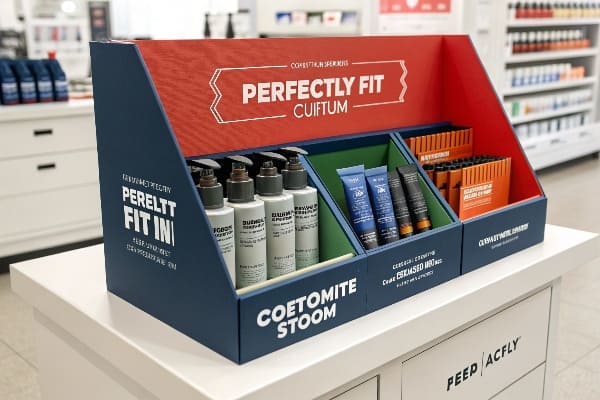
Fit and conversion
I size pockets to the exact product. I angle headers to the shopper’s eye line. I place claims where hands pause. For a hunting brand launch, I built a compact floor unit for crossbow accessories. The footprint hit the aisle spec, and the hook layout fit heavy packs. Sell-through rose in week one because shoppers saw the kit path fast.
Operations and risk
I design for fast assembly5 with clear numbers and arrows. I remove loose hardware and use auto-locks where I can. This cuts setup time on store floors. I control color with a simple profile and a printed master key, so what the buyer sees in the sample is what ships in bulk. I run pilot packs with real transit to prevent surprises. I share FSC and other proofs when the buyer needs them.
Proof and iteration
I send 3D renders for alignment. I ship white-box samples when speed matters. I revise until the team signs off. I accept small losses in prototyping because repeat orders cover cost. This model lets me serve strict timelines without stress.
| Feature | Outcome | Note |
|---|---|---|
| Tailored structure | Better product fit | Less damage |
| Targeted graphics | Faster decisions | Clear one-line claim |
| Fast assembly | Lower labor | Numbered panels |
| Color control | Brand trust | Press proofs |
| Verified materials | Buyer approval | FSC, recycled content |
Conclusion
Cardboard display boxes make products seen, stocked, and sold. Good design sets speed, strength, and story in balance. Clear terms and tight proofs keep launches on time.
Learn about FSC certification and the significance of using recycled materials in packaging for sustainability. ↩
Understanding point-of-purchase displays can enhance your retail strategy and improve sales. ↩
Exploring the impact of floor displays can help you optimize product placement and boost customer engagement. ↩
Learn about the significance of drop and vibration checks to ensure product safety during transport. ↩
Exploring this resource will reveal how fast assembly can enhance efficiency and reduce labor costs in product design. ↩
